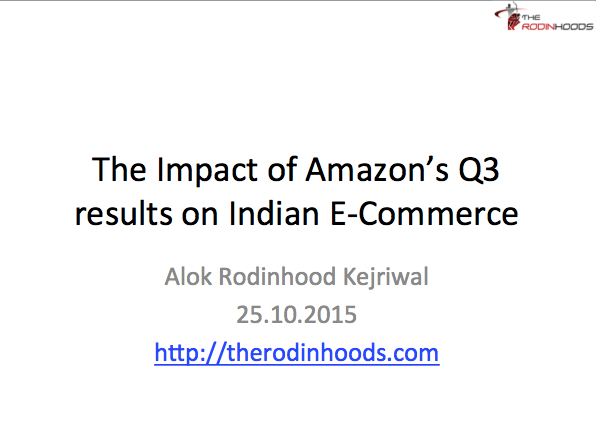Amazon had a blockbuster 3rd Quarter and its detailed break down of its results inspired me to analyse some the key slides and create a view on what impact these results may have on Indian E-Commerce Companies.
This narrative is particularly important considering that Amazon is almost as close to the traffic metrics of the #1 E-Com player in the country(Flipkart) as elaborated by this Times of India Article that featured this tell tale comScore chart:

Here are a few key slides & my accompanying argument that appears after each slide:
1. Slides relating to Sales (TTM = Trailing Twelve Months)



What this means: 1) Amazon’s Sales are increasing and International Sales (India + Others) is a significant chunk. 2) In the USA it makes profits; abroad it makes losses on its sales.
The impact on Indian e-com: Amazon is proud of its Indian story as evident by the call-out in the earnings call. The right chart in the second slide above clearly shows that Amazon makes losses in India (and other International markets). It’s a clear public strategy of Amazon that will only gain momentum. Indian e-com players will have to contend with this especially given that Amazon is now publicly vocal about its Indian losses.
2. Slides on AWS (Amazon Web Services)

What this means: AMAZON MAKES MASSIVE MONEY FROM ITS CLOUD BUSINESS
The impact on Indian e-com: Ask anyone, “What is Amazon?” They will say, “An e-com Company”. But look at the slide above! Amazon has a Rs. 45,000 CRORE yearly cloud business which is highly profitable! THIS IS THE KILLER from Amazon. Its cloud business will be a Cash Fire hose that will keep funding its International (India & others) Business – much to the discomfort of our local players.
3. Slides on Profitability


What this means: Amazon makes operational profits quarterly and for Trailing Twelve Months (TTM)
The impact on Indian e-com: As Indian e-com companies plan to list in the USA (Indian Stock Markets do not allow loss-making companies to list themselves yet), the buyers of such stock are going to compare Amazon and Alibaba’s profitability with new Indian e-com Stock. Also, given that Amazon operates in India means that its shareholders are already participating in the Indian Story. So the question will be (at least in my mind), “Why buy a new going-to-list Indian e-com Co that makes only losses”?
4. Slides on Cash Flow


What this means: Amazon is generating mountains of CASH even AFTER paying for hard assets like computers, leases, etc. (see image above)
The impact on Indian e-com: Amazon is a CASH machine. It’s generating enough cash not just to balance it’s operations and loss making businesses in India, but also to pay for its hardware and new leases (warehouses, etc.). Cash IS the fuel of loss making Indian e-com Companies and Amazon seems to have a free, ever growing supply!
5. Slides on Digital Goods Sold

What this means: Amazon cannot scale its ‘digital goods business’ – its growth in the USA is a struggle and outside of the USA, it is de-growing.
The impact on Indian e-com: Clearly, the sales of ‘non-physical’ goods remain a challenge in India. Unlike iTunes and Google Play, even Amazon is struggling to grow its App Store business in the USA and in markets like India it’s even more challenging. All Indian e-coms will have to struggle with this reality.
6. Slides on “Other Income”

What this means: Amazon makes thousands of Crores from “Ads, Credit Cards”, etc.
The impact on Indian e-com: Given that Amazon operates with massive scale in the USA, its supplementary income is phenomenal and laced with massive margins. This is a ‘side business’ that provides easy cash – all of which can be used for anything by Amazon.
7. Slides on Dilution

What this means: Amazon does NOT sell more shares 🙂
The impact on Indian e-com: Amazon shareholders aren’t getting diluted while enjoying this massive success. This is quite the opposite of Indian e-com Companies whose VCs are adding on rounds after rounds in the Companies, hoping for growth and profitability. Sometime down the line, high cost capital will become ‘impatient’..?
This is the source of the slides
I have also compiled these slides in a deck that you are free to view/download. If you are viewing via a mobile device, you could click on the ‘In’ link and review this deck on slideshare directly.
Please do share, comment and point out any errors and omissions I may have made!
Click here to download the PPT






Sridhar Rajendran
Quite an informative post.